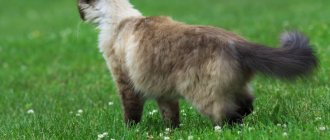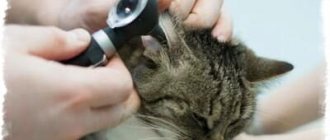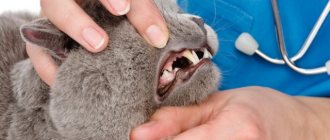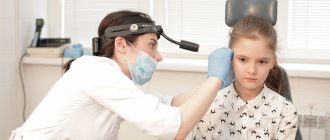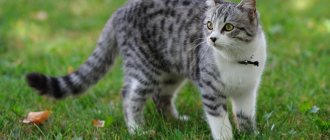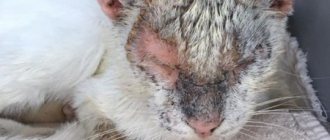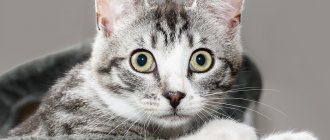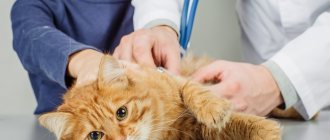Domestic cats often experience inflammation of the paraanal glands. However, many owners do not even know that their pet has them and what functions these glands perform. So that you can help your cat in a timely manner and prevent consequences dangerous to its health, see the most useful information about the signs and causes of inflammation of the paraanal glands.
Read in this article:
What are paraanal glands? Common causes of inflammation Signs of inflammation and abscess Treatment: main stages and methods
- Cleaning
- Washing
- Removal
Recovery after treatment Prevention of inflammation of the paraanal glands
What are paraanal glands?
Anal (paraanal) glands are paired glands located at the anus. They look like small “bags” and secrete a secretion that performs various functions. One of them is recognizing the opposite sex and attracting them for further mating.
Other functions performed by the paraanal glands:
- protection from enemies (scaring away),
- marking the occupied territory,
- maintaining metabolism in the body,
- attracting partners.
During inflammatory processes, the functions of the glands are disrupted. Because of this, the pet experiences serious discomfort. In advanced cases (for example, with the development of an abscess), this problem can lead to serious and irreversible consequences. However, it is possible to avoid them if you know all the most important things about the causes and signs of inflammation.
Anatomy of the rectum and perianal region, functions of the obturator apparatus
The rectum and anal canal are the final sections of the digestive tract. The immediate tasks of the rectum are the accumulation, formation and excretion of intestinal contents and gases. The functions of the anal canal are unique: a system of nervous reflexes and a complex muscle complex provide one of the most important functions of the body - control of bowel movements, as well as differentiation of the composition of intestinal contents without the need for conscious assessment and subsequent “smart” control of evacuation. In other words, a healthy person most of the time does not think about what kind of contents are in the rectum, whether it is necessary and whether it is possible to retain it in a given situation. All this is controlled unconsciously, thanks to multi-level neuromuscular self-regulation of the holding process.
The approximate boundary between the rectum and the anal canal on the side of the mucous membrane (lumen) of the intestine is formed by the so-called dentate line. There are vertical folds on it, alternating with depressions - crypts. The ducts of the anal glands open into the crypts. The mucus produced by these glands facilitates the sliding of intestinal contents as they pass through the anal canal. Circumstances such as trauma, swelling of the mucous membrane due to defecation disorders, chronic intestinal diseases can lead to inflammatory changes in the crypts and anal glands.
Outside the mucous membrane there is a complex of muscles - these are the sphincter muscles mentioned above, which provide the function of retention and excretion. There are internal and external sphincters. The internal sphincter forms the so-called resting tone, uninterruptedly ensuring the tightness of the anal canal. Its regulation and reduction occur unconsciously, that is, without our will. The external sphincter surrounds the internal one and consists of several layers (portions). Its reduction occurs due to our volitional effort (Fig. 1).
Figure 1. Schematic representation of the rectal sphincters
Common Causes of Inflammation
Inflammation or abscess of the paraanal glands often develops with trauma and mechanical damage to this area (for example, falls from a great height). This leads to dysfunction of the glands, disruption of the outflow of secretions and its subsequent accumulation. All this provokes the development of an inflammatory process involving pathogenic microflora.
Most often, long-haired cats living in apartments face the problem of inflammation of the paraanal glands. This is due to the fact that they lose the natural ability to cleanse the anal sacs (due to the absence of potential enemies and the need to defend themselves from them).
Common causes of inflammation of the paraanal glands:
- dysbacteriosis (for example, due to prolonged use of antibiotic drugs by the pet),
- helminthic infestations,
- eating small bones
- feeding mass market liquid food,
- lack of physical activity,
- injuries to the anus and anal area,
- disorders of the gastrointestinal tract, accompanied by frequent constipation.
Older cats are more prone to inflammation and abscess of the anal glands. One of the factors that can affect the development of the inflammatory process is that the pet’s gland channels are too narrow from birth. Veterinarians include cat pregnancy and excess weight (obesity) as additional provoking factors.
Without timely veterinary care, the animal will develop complications. The inflammatory process can quickly develop into an abscess (purulent inflammation), which poses a threat not only to the health, but also to the life of your pet. That is why, when the first signs of a problem appear, you need to contact a veterinary clinic in Moscow as soon as possible.
Signs of inflammation and abscess
Signs of inflammation develop gradually. They are accompanied by an increasing painful symptom. Due to pain and itching, the cat constantly licks the area of inflammation (tail and anus). The pet stops playing, spends time in solitude, practically does not move and constantly lies down. However, this is not the only symptom.
Other signs characteristic of inflammation of the paraanal glands:
- weakness,
- apathy,
- unpleasant specific odor from the pet’s body (does not disappear after washing),
- poor appetite (in later stages – refusal to eat),
- painful bowel movement,
- discharge from the anal glands.
With an abscess, this condition is accompanied by purulent or bloody discharge. In especially severe cases, body temperature rises. When stroking the affected area, the pet shows aggression and anxiety. Defecation is accompanied by severe pain, so the cat meows loudly on the tray.
How common is rectal fistula?
The incidence in European countries is about 10-25 people per 100 thousand population. Mostly people of working age suffer from rectal fistulas. Men get sick 2-3 times more often than women.
Important! This disease, being benign, can dramatically reduce a person’s quality of life. A serious and most common complication of inadequate treatment of perianal fistulas is impaired holding function due to damage to the muscular apparatus of the anal canal.
Treatment: main stages and methods
Treatment of inflammation or abscess of the paraanal glands should only be carried out by an experienced veterinarian in Moscow. We strongly do not recommend trying to help your pet at home. This will only worsen an already difficult situation.
The first step in treating inflammation is diagnosing the animal's condition. The veterinarian examines the affected area, interviews the owner (about the severity of symptoms, the degree of their manifestation, etc.), after which he assesses the cat’s condition and prescribes treatment.
Cleaning
If you consult a doctor in a timely manner (at the first stage of the inflammatory process), then treatment will be limited to cleaning the paraanal glands. This procedure does not require special conditions, so it can be performed in the clinic or at home, but only by a professional veterinarian.
Before cleansing the glands of accumulated secretion and secretion, it is necessary to palpate them. This will allow you to determine the consistency of the contents and select a cleaning method. If the secretion is liquid, then the external method is used, if it is dense, the method of rectal sanitation is used.
After cleaning is completed, the affected area is thoroughly treated using an antiseptic solution. To prevent further inflammation (preventive measure), an anti-inflammatory suppository is inserted inside.
Washing
Unlike external cleaning, washing the paraanal glands cannot be done at home. It is carried out only in a veterinary clinic, since it is prescribed in difficult situations (for example, when a fistula forms).
Before washing the abscess, the glands are cleared of accumulated secretions, then an injection is given with local anesthesia. Next, the specialist injects an antiseptic solution into the anus using a catheter (an alternative is a syringe without a needle).
Washing is carried out not once, but several times. This is necessary so that the liquid flowing back (antiseptic solution) becomes completely transparent. This condition indicates that there is no secretion or purulent discharge left.
After washing, the pet is given an anti-inflammatory suppository, and the damaged area is carefully treated with antiseptic ointment. If the cat's condition is of concern, the specialist will prescribe a course of antibiotics.
Removal
Unfortunately, washing does not always give a positive result. In particularly severe situations (for example, with a developed abscess), the veterinarian resorts to an extreme method of treatment - surgical removal of the paraanal glands.
The surgery is performed using general anesthesia. The surgeon makes two incisions in the area where the glands are located, and then removes them along with the ducts. Then he puts stitches and treats with an antiseptic solution.
After surgery, your cat will need home care. In order for it to fully recover, it is necessary to regularly treat the area with regenerating agents (solutions, ointments), give vitamins and antibiotics for 7-10 days.
What happens if you do not contact a veterinarian in time if there is a pathology?
Don't think that the problem will solve itself. As we have already said, the accumulated secretion in the anal sacs becomes an excellent breeding ground for the proliferation of pathogenic bacteria. If clogged anal glands are not cleared, your pet will require lengthy and complex treatment.
Signs of a worsening situation are:
- pain experienced by the pet during bowel movements (he may whine, grunt, etc.);
- hair loss;
- redness of the tissues near the anus;
- wet areas;
- presence of fistulas;
- swelling in the anal area;
- presence of irritation, etc.
In such cases, the animal needs urgent help from a specialist. You cannot clean the anal glands yourself!
Recovery after treatment
After cleaning, rinsing or removing the anal glands, your cat requires special care. This will allow her body to recover faster and avoid unwanted consequences. The first thing that is necessary is to ensure the pet's comfort. Set up a bed for him in a warm place without drafts or blowing.
Maintain a therapeutic diet for 10-14 days. Eliminate solid food completely and provide constant access to fresh drinking water. Avoid excess carbohydrates in your animal's diet. It must be completely balanced so that the cat quickly recovers from a severe inflammatory process.
Prevention of inflammation of the paraanal glands
Inflammation and abscess of the paraanal glands are a serious blow to your cat's health. However, it is possible to avoid it. The main thing is to follow simple recommendations for prevention from experienced veterinarians.
Adviсe:
- Your pet should lead an active lifestyle (in accordance with its age). If you don't have much time, special toys and exercise equipment for cats will help with this.
- If your animal's anal glands are often clogged, consult a specialist and discuss the issue of removing them.
- Try to avoid cheap liquid food and do not give your pet small bones, as well as foods that can cause gastrointestinal injury.
- At the first signs of inflammation, consult a doctor. Don't forget about regular preventive examinations.
- Carry out anthelmintic treatment once every 6-12 months. This completely eliminates the possibility of developing parasitic diseases.
Inflammation or abscess of the paraanal glands is dangerous to the health and life of the cat. A seemingly insignificant problem can lead to dangerous consequences, including death. That is why we strongly recommend that you follow preventive measures, and if the first signs of inflammation appear, contact your veterinarian immediately!
Symptoms of the disease
Late diagnosis and treatment of this pathology provokes serious complications in the animal’s body. There are three main signs of perianal inflammation in cats.
They are as follows:
- The animal regularly licks and bites at the base of the tail;
- The cat begins to scratch the anus on the floor surface;
- While moving, the pet begins to limp. His gait may appear wobbly and hopping.
There are a number of additional symptoms of paraanal inflammation in cats. These include:
- The tail is constantly pressed to the anus;
- The animal emits a foul odor that does not disappear after bathing with detergents;
- The cat's anus appears dirty and swollen in appearance;
- The animal's appetite sharply decreases and its health deteriorates.
The inflammatory reaction is most often accompanied by the appearance of high temperature. When initial symptoms appear, it is recommended to carefully examine the cat's anus.
If swelling, a pungent odor and redness of the mucous membranes appear, you should immediately contact a veterinarian.
